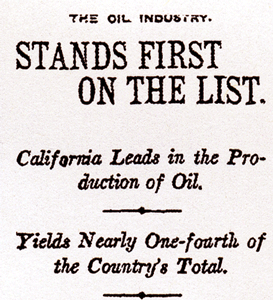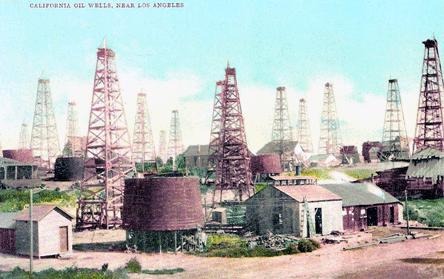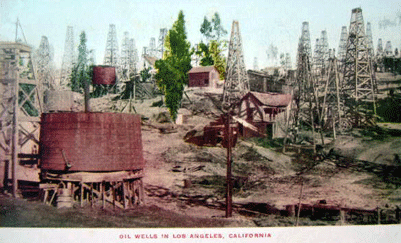Los Angeles
I don
 Nov. 24, 1907
Nov. 24, 1907The Times real estate section takes a look at what was then the distant suburb of Monrovia, 22 miles from downtown Los Angeles. The writer notes the increasing use of concrete and stone, explai ning that the cost of lumber is forcing builders to use other materials. The writer also notes the broad, shaded verandas of three featured homes as well as the outlines of their roofs.
ning that the cost of lumber is forcing builders to use other materials. The writer also notes the broad, shaded verandas of three featured homes as well as the outlines of their roofs.
The story highlights the home of B.R. Davisson on East Orange Avenue, H.M. Slemmons (or Slemon) on North Myrtle Avenue and the home of John C. Rupp at Ivy and Greystone, built for $6,500 ($133,403.21 USD 2005).
Without exact addresses, it would be difficult for me to locate the Davisson and Slemmons homes, but I took a pleasant drive out to Monrovia recently to look for the Rupp house and was happy to find
that it is still standing and in beautiful condition. In fact, it was nice to discover that the neighborhood has quite a few well-maintained historic homes; a contrast to the condition of the houses I located in Pico Heights.
I had a brief chat with the homeowner who gave me a tour of the grounds. He said that Rupp, a financier, built the home for his wife, but that she decided it was too far from Los Angeles and wouldn

Nov. 23, 1907
South Pasadena
Warning: This is a grotesque, tragic story with graphic details.
Pasadena Detective Wallace H. Copping is investigating the murder of a young baby boy, whose half-eaten body was found in a pigpen on the Berry ranch in South Pasadena.
Authorities say the boy, weighing about 14 pounds and less than 10 days old (yes, quite a large baby by today’s standards), was discovered by Mrs. J.H. Anderson, whose husband leases the ranch. Apparently Mr. Anderson picked up the baby

 Nov. 18, 1907
Nov. 18, 1907 Nov. 16, 1907
Nov. 16, 1907Mrs. Amanda Cook (she is also identified as Jennie and Mary) came to Los Angeles from Boston in 1906 with two of her children in search of her husband, Frederick, a union plasterer and bricklayer. She advertised in the newspapers without success and finally took a job as a cook at the Juvenile Detention Home.
Persuaded by her cousin to seek a divorce, she hired attorney George W. MacKnight, who sought out her errant husband and began divorce proceedings.
One day, after being threatened with divorce, Frederick appeared at the juvenile home and upon seeing his wife, said:
Lisa Sweetingham of CourtTV rode the Halloween Horrors Crime Bus, and reports in with a charming little feature she calls "The bus ride to hell, and back."
LOS ANGELES — "Ladies and gentlemen, this tour should not be taken by anyone with a heart condition … We recommend you leave the bus immediately." A tour guide makes the announcement as the doors slam shut on our filled-to-capacity 56-seat cruising bus. We are rolling into Los Angeles noir, embarking on an exhaustive five-hour tour of grisly crime scenes and lesser Halloween hijinks from the ’20s to the ’50s.
The 1947project’s inaugural Halloween Horrors crime bus tour is touted as a BYOBB (Bring Your Own Barf Bag) event. And no children are allowed.
So why is there a clown breathing down my neck?
Crimebo the crime clown (aka Michael Perrick) bares his teeth and purrs in a gravelly voice as he walks down the aisle with a cauldron full of cheap candy, some shaped like eyeballs. "Something sticky?" he offers.
He pops a balloon animal and quips, "These things just keep committing suicide."
Kindly click to read on.
Nov. 10, 1907
South Pasadena
What sort of monument do we leave for real estate developers? For John B. Althouse, who built hundreds of homes in the Wilshire district, as well as the West Adams district and the San Gabriel Valley, the answer might be nondescript offices and vacant lots.
Here”™s the house he built for himself at Oxley and Fremont in South Pasadena, a few blocks from my home. In fact, I pass the corner every day.
Here”™s another one he built on Manhattan Place.
Don”™t rush out to look for them, though. They”™re gone, although the wall around Althouse”™s home survived.
Born in Baltimore, Althouse died in July 1939 at the age of 72 at his home, 230 S. Gramercy Place. He arrived in Los Angeles in 1886 and spent 37 years in the real estate business after operating a fruit store at 1st and Main Streets for many years. He constructed hundreds of homes in the Wilshire district and was one of the first members of the Los Angeles Realty Board.
What”™s this? One has survived in the West Adams district, 1415 S. Gramercy Place. Also read here. And here. Zillow link.
Lmharnisch.com
Lmharnisch.blogspot.com
e-mail: lmharnisch (AT) gmail.com
 Update: Further research reveals the home of Daniel T. Althouse, a partner in Althouse Brothers, at 2125 S. 4th Ave., where he died of blood poisoning in 1914.
Update: Further research reveals the home of Daniel T. Althouse, a partner in Althouse Brothers, at 2125 S. 4th Ave., where he died of blood poisoning in 1914.
November 6, 1907
Los Angeles
Oil facts, you say? And you continue to comment, I thought this was a crime blog! Well, the way most people talk about oil companies, you’d think the SS was Toys for Tots. So it’s apropos, especially as we head into Tuesday and face the outcome of Proposition 87.
On this day in 1907, according to the US Geological Survey, the numbers were in: in 1906, California produced 23,098,598 barrels of oil. That’s more than Oklahoma and Kansas combined. (Texas came in with a paltry 12.5 million barrels.) Our oil came primarily from Kern River, Coalinga, Santa Maria, with Los Angeles finishing fourth. The value of California’s 23M barrels came in at 9.5M dollars ($194,973,917 USD 2005). One-sixth of that oil was exported to Japan, Chile, and the American Panama Canal Works.
Today, California is no longer number one (behind Louisiana, Texas and Alaska) but we’re far ahead of those dried-up old fields in Oklahoma and Kansas. In 2007 California should come in with about 274M barrels, over ten times that of 1907. And that, with a value of approximately 16.5B (804M USD 1907). And we’re at our lowest oil production since WWII.

